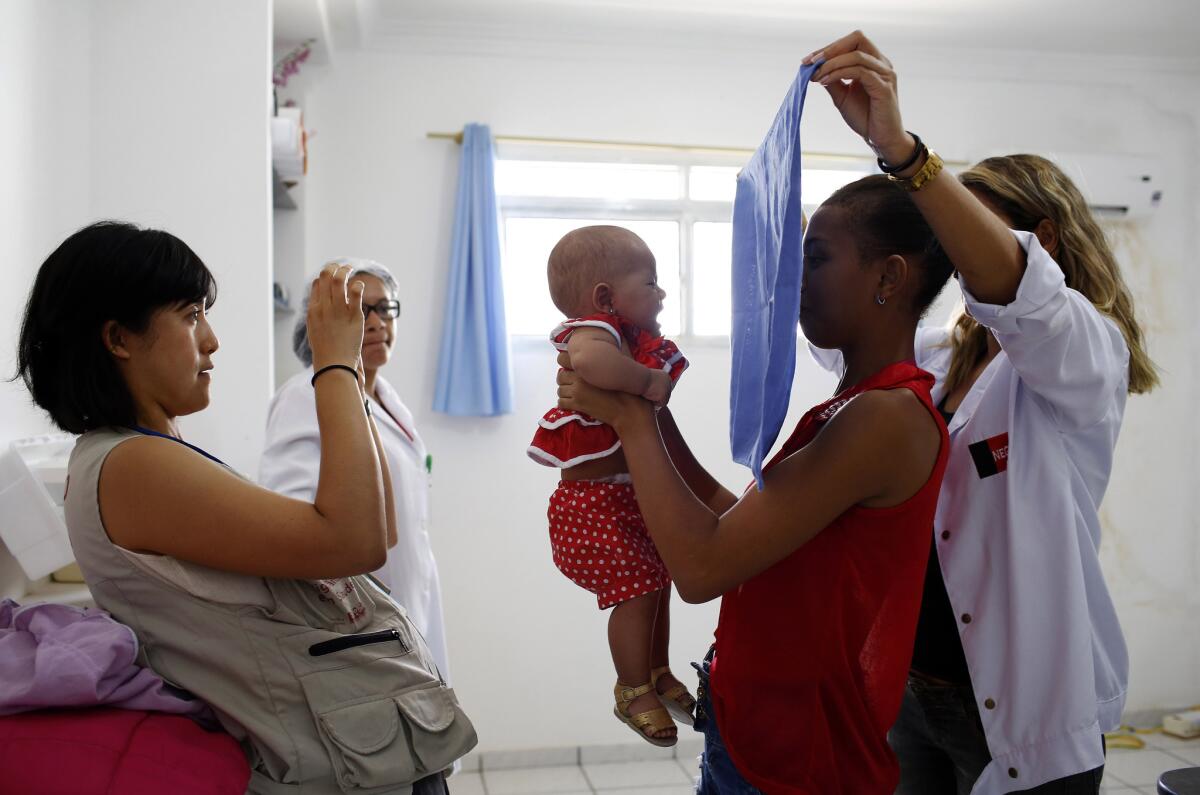Chasing an epidemic: On the road with Brazil’s Zika detectives

- Share via
Reporting from Juazeirinho, Brazil — In a place where the bite of a common mosquito has brought crippling birth defects and early death, they are the detectives sent to gather clues about the crime.
The four women have been plying the back roads of northeastern Brazil for days. Their quarry: new mothers who may have been infected with the Zika virus during their pregnancies.
Conceicao Alcantara, a 34-year-old woman who’d given birth the month before, was on their list. Her daughter was born with microcephaly, a serious condition that afflicts some babies whose mothers have been exposed to the virus, leaving them with an abnormally small skull, and often an underdeveloped brain.
Alcantara had been reluctant to speak to the investigators -- an American pediatrician, and two nurses and a phlebotomist from Brazil. She didn’t want her tiny daughter turned into a public curiosity, she said.
As a physiotherapist herself who’d worked with microcephalic babies, she already knew the condition’s devastating potential impact: seizures, learning disabilities, problems with speech, vision, hearing and motor function, and for some, a shortened life span.
Were these researchers going to accomplish anything?
A local health worker agreed to bring the team to Alcantara’s house to see if she might be persuaded. The health worker guided the group’s small Fiat down narrow, cobblestone streets to a cream-colored house behind a forbidding metal gate.
Marcia de Andrade, one of the nurses on the team, banged on the gate while the others stayed in the car. The gate opened a crack, and De Andrade disappeared inside.
She was gone nearly an hour. Finally, the gate opened again, and De Andrade motioned for the rest of the team to come inside.
--
There is now strong scientific consensus that Zika, which for decades was thought to be relatively harmless and often has no symptoms, can cause microcephaly and other serious neurological damage. But there is much that scientists still don’t know.
Why are only some babies whose mothers were infected during pregnancy affected, while others are not?
How high is the risk? Is exposure more dangerous in certain trimesters? Are there other factors that increase the chances that Zika will cause birth defects?
The U.S. Centers for Disease Control and Prevention in February dispatched researchers to Brazil, which has seen an increase in microcephaly cases unparalleled elsewhere in the world, to help unravel the mystery.
Over the next month, the team in the Fiat and seven others like it fanned out across the northeastern state of Paraiba, logging thousands of miles down undulating country roads and narrow alleyways.
Zika has now reached 60 countries and territories, including large swaths of the Americas where there is an abundance of the Aedes aegypti mosquito that spread the virus -- and almost no one has the immunity that has developed in parts of Africa and Asia.
In the United States and its territories, 279 pregnant women have tested positive for likely exposure, federal health officials recently announced.
As of Wednesday, Brazilian health authorities had confirmed 1,434 births since October with malformations that may be Zika-related and were investigating thousands of others.
Zika is believed to have arrived in Brazil in 2014, most likely brought in by a traveler from the Pacific Islands.
The increase in microcephaly cases began in August in the state of Pernambuco, just south of Paraiba. Genetic disorders, certain viruses and other known causes of microcephaly did not seem to be an issue in these cases.
Something else was going on, and Alcantara’s pregnancy became a key piece of the puzzle.
Her obstetrician had noticed during an ultrasound that the fetus’ head was not developing normally, and then heard of the cases of microcephaly in nearby Pernambuco.
Those cases, doctors were beginning to suspect, might be linked to Zika. Many of the women had experienced a rash typical of the virus early in their pregnancies -- did Alcantara remember having a rash?
She did.
Her doctor found a lab that could test for Zika in her amniotic fluid, and it was positive. The finding was a breakthrough -- some of the first biological evidence connecting the virus to microcephaly.
“Never before in history has there been a situation where a bite from a mosquito could result in a devastating malformation,” said Dr. Thomas Frieden, the CDC director.
Over the coming months, the evidence favoring a Zika connection mounted. Other countries with outbreaks started reporting cases of microcephaly. Brain tissue collected from still births tested positive for the virus, as did spinal fluid from babies with microcephaly.
Here in Paraiba, the detectives started with a list of more than 800 reported cases of microcephaly in the region, which they winnowed to a sample of 190. They focused on severe cases, based on the head’s circumference at birth — 32 centimeters for boys and 31.5 centimeters for girls — as well as its size relative to body length. Just 3% of newborns have heads that small.
For each mother who agreed to take part, the researchers wanted to enroll, as a control, three others whose babies were born at around the same time and in the same place but who did not have microcephaly.
Dr. Megumi Itoh, the San Francisco pediatrician who was on the team with De Andrade, worried how families would respond to strangers showing up at their homes, asking intimate questions and taking blood samples.
The researchers had a bigger challenge first: finding them. The mothers were spread across nearly 22,000 square miles, from the densely populated coast to the hinterlands of the interior.
The teams set out in the state capital, Joao Pessoa, often with little more than a name and a neighborhood. They went from clinic to clinic searching for more information.
“We would literally go in and say, ‘Do you know this mom?’” Itoh said.
When the teams located an address, the mother might not be home. “We were going in circles.”
They needed a better strategy.
--
Shortly after 7 a.m., the Fiat pulled out from a hotel in Campina Grande. Motorcycle taxis buzzed past in the morning traffic.
The team had set up a base in the inland city from which to target small rural towns, sometimes hours away. Now, they were networking with community health workers who knew the families and could arrange meetings at local health facilities.
They had five appointments ahead of them for the day.
The small car picked up speed. Grimy high-rises gave way to rolling green hills dotted with one-street towns, where residents set out chairs to watch the trucks, cars and horse-drawn carts roll buy. Chickens scratched in yards behind walls of cacti. Guava trees perfumed the air.
In Sao Vicente do Serido, an elderly shopkeeper pointed the researchers toward the municipal health secretariat on a cobblestone street of houses painted pastel yellow, blue and green.
The town recently had its first case of microcephaly, and expectant mothers were desperate to know if their babies might also be at risk.
“It is so good to have you,” said Constanca Goncalves, a primary care coordinator, as she led the team into an office.
The researchers sorted through reams of paperwork and used a pink pillow to turn a cabinet into an examination table.
Two mothers were waiting to see them, while another hadn’t shown up yet. All had healthy babies and were there to serve as control cases.
A shy mother in shorts and a tank top entered the room cradling a sleeping baby girl. But there was a problem. The mother, Maria Girdielly, was 17. They needed a parent’s consent to enroll the pair in the study.
Goncalves pulled up a number on her cellphone and dialed the girl’s mother. She was busy making lunch for her employer.
“Can you just come sign the paperwork?” Goncalves pleaded. “We will come in a car to get you and bring you right back.”
The Fiat was dispatched, and 10 minutes later Maria’s mother, Creusa dos Santos, walked into the room. She looked nervous.
“You have a chance to help a lot of other mothers,” De Andrade said.
The woman signed the forms.
--
In the afternoon, they visited a clinic in Juazeirinho, the town where they would meet Alcantara the next day.
Waiting for them was Sabrina Mateus, her mother and 2-month-old son, who was born with microcephaly.
After measuring the infant’s head, Itoh took photographs to document its shape and proportions.
De Andrade assured the 17-year-old mother that they would not be shared on social media networks — a worry in a country where curiosity about the condition has meant that its victims are sometimes treated like characters in a national freak show.
The baby screamed as another team member drew a sample of his blood, then one from his mother. An antibody test would indicate whether they had been exposed to the virus.
Did she experience any rashes during her pregnancy, De Andrade asked the mother.
Any fever? Headaches? Joint pain? Red eyes? She shook her head no.
Had she had any other infections? Was she exposed to pesticides? Did she drink? No.
De Andrade wrote down each answer on a standardized form. The questions continued for half an hour.
After meeting with another mother, the detectives sped back to the hotel in Campina Grande. There were still hours of work ahead of them, entering the day’s interviews into a computer database and confirming appointments for the next day.
As they worked, mosquitoes drifted through the rooms.
--
Many Brazilians remain doubtful that the surge in microcephaly can be traced to Zika.
Various other theories have gained popular currency. Some want to blame the epidemic on expired vaccines; others on a British biotech firm that has been releasing genetically modified mosquitoes to combat dengue fever, or a larvicide used by the government to prevent mosquitoes from breeding in standing water.
Government officials hope the study will provide a definitive answer.
In the end, 600 mothers agreed to participate in the research.
A preliminary analysis was not surprising: Mothers whose babies have microcephaly were more likely than other women to have experienced symptoms during pregnancy that could be caused by Zika. There were no other obvious explanations for the epidemic.
But researchers still need to analyze the blood samples to begin to figure out how many of the women were infected with Zika, and why many of the babies were born healthy while others have lives that are forever changed.
Itoh understands that the puzzle she’s solving, even as she works at it, is laying new jigsaw pieces around the world. But that only means the disease detectives need to hurry.
“It’s mind-boggling to me that a virus could do this,” she said.
Twitter: @alexzavis
This story was reported with a grant from the United Nations Foundation.
More to Read
Sign up for Essential California
The most important California stories and recommendations in your inbox every morning.
You may occasionally receive promotional content from the Los Angeles Times.













